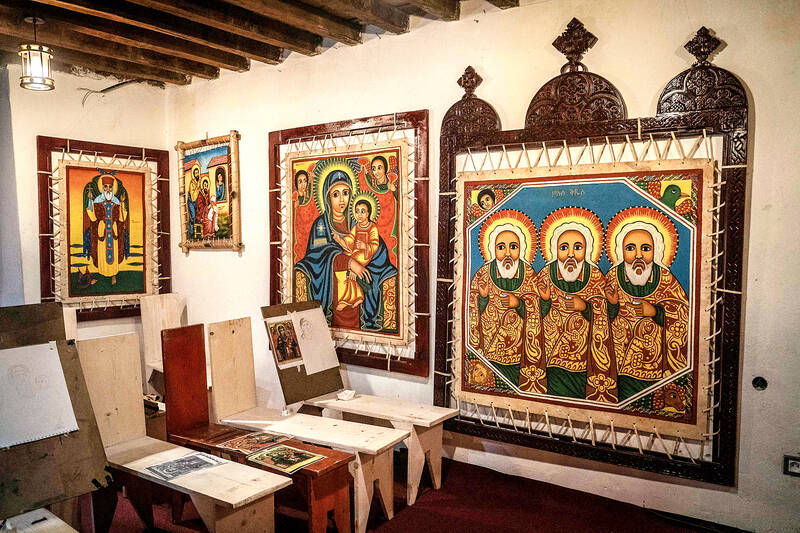Armed with a bamboo ink pen and a steady hand, Ethiopian Orthodox priest Zelalem Mola carefully copies text in the ancient scriptural language Geez from a religious book onto a goatskin parchment.
This painstaking task is preserving an ancient tradition, while bringing him closer to God, 42-year-old Mola said.
At the Hamere Berhan Institute in Addis Ababa, priests and lay worshipers work by hand to replicate sometimes centuries-old religious manuscripts and sacred artwork.

Photo: AFP
The parchments, pens and ink are prepared at the institute, in the Piasa district in the historic heart of the Ethiopian capital.
Hamere Berhan head of communications Yeshiemebet Sisay, 29, said the work began four years ago.
“Ancient parchment manuscripts are disappearing from our culture, which motivated us to start this project,” she says.
The precious works are mainly kept in monasteries, where prayers or religious chants are conducted using only parchment rather than paper manuscripts.
“However, this custom is rapidly fading... We thought if we could learn skills from our priests, we could work on it ourselves, so that is how we began,” Yeshiemebet said.
In the institute’s courtyard, workers stretch the goatskins tightly over metal frames to dry under a weak sun.
“After the goatskin is immersed in the water for three to four days, we make holes on the edge of the skin and tie it to the metal so that it can stretch,” Tinsaye Chere Ayele said. “After that, we remove the extra layer of fat on the skin’s inside to make it clean.”
Once clean and dry, the skins are stripped of the goat hair and cut to the desired size for use as pages of a book or for painting.
Yeshiemebet said that most of the manuscripts are commissioned by individuals who donate them to churches or monasteries.
Some customers order small collections of prayers or paintings to have “reproductions of ancient Ethiopian works,” she said.
“Small books can take one or two months. If it is a collective work, large books can take one to two years. If it’s an individual task, it can take even longer,” she said.
Sitting in one of the institute’s rooms, with parchment pages placed on his knees, Zelalem patiently copies a book, entitled Zena Selassie — “History of the Trinity.”
“It is going to take a lot of time. It’s hard work, starting with the preparation of the parchment and the inks. This one could take up to six months to complete,” Zelalem said. “We make a stylus from bamboo, sharpening the tip with a razor blade.”
The scribes use different pens for each color used in the text — black or red — and either a fine or broad tip, with the inks made from local plants.
Like most other religious works, Zena Selassie is written in Geez.
This dead language remains the liturgical language of the Ethiopian Orthodox Church and its alpha syllabic system — where the characters represent syllables — is still used to write Ethiopia’s national language, Amharic, as well as Tigrinya, which is spoken in Tigray and neighboring Eritrea.
“We copy from paper to parchment to preserve [the writings] as the paper book can be easily damaged, while this one will last a long time if we protect it from water and fire,” Zelalem said.
Replicating the manuscripts “needs patience and focus. It begins with a prayer in the morning, at lunchtime, and ends with prayer,” Zelalem said.

Kehinde Sanni spends his days smoothing out dents and repainting scratched bumpers in a modest autobody shop in Lagos. He has never left Nigeria, yet he speaks glowingly of Burkina Faso military leader Ibrahim Traore. “Nigeria needs someone like Ibrahim Traore of Burkina Faso. He is doing well for his country,” Sanni said. His admiration is shaped by a steady stream of viral videos, memes and social media posts — many misleading or outright false — portraying Traore as a fearless reformer who defied Western powers and reclaimed his country’s dignity. The Burkinabe strongman swept into power following a coup in September 2022

A new online voting system aimed at boosting turnout among the Philippines’ millions of overseas workers ahead of Monday’s mid-term elections has been marked by confusion and fears of disenfranchisement. Thousands of overseas Filipino workers have already cast their ballots in the race dominated by a bitter feud between President Ferdinand Marcos Jr and his impeached vice president, Sara Duterte. While official turnout figures are not yet publicly available, data from the Philippine Commission on Elections (COMELEC) showed that at least 134,000 of the 1.22 million registered overseas voters have signed up for the new online system, which opened on April 13. However,

‘FRAGMENTING’: British politics have for a long time been dominated by the Labor Party and the Tories, but polls suggest that Reform now poses a significant challenge Hard-right upstarts Reform UK snatched a parliamentary seat from British Prime Minister Keir Starmer’s Labor Party yesterday in local elections that dealt a blow to the UK’s two establishment parties. Reform, led by anti-immigrant firebrand Nigel Farage, won the by-election in Runcorn and Helsby in northwest England by just six votes, as it picked up gains in other localities, including one mayoralty. The group’s strong showing continues momentum it built up at last year’s general election and appears to confirm a trend that the UK is entering an era of multi-party politics. “For the movement, for the party it’s a very, very big

ENTERTAINMENT: Rio officials have a history of organizing massive concerts on Copacabana Beach, with Madonna’s show drawing about 1.6 million fans last year Lady Gaga on Saturday night gave a free concert in front of 2 million fans who poured onto Copacabana Beach in Rio de Janeiro for the biggest show of her career. “Tonight, we’re making history... Thank you for making history with me,” Lady Gaga told a screaming crowd. The Mother Monster, as she is known, started the show at about 10:10pm local time with her 2011 song Bloody Mary. Cries of joy rose from the tightly packed fans who sang and danced shoulder-to-shoulder on the vast stretch of sand. Concert organizers said 2.1 million people attended the show. Lady Gaga